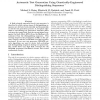29 search results - page 4 / 6 » Improved Fault Emulation for Synchronous Sequential Circuits |
DAC
2009
ACM
14 years 8 months ago
2009
ACM
Continuously shrinking feature sizes result in an increasing susceptibility of circuits to transient faults, e.g. due to environmental radiation. Approaches to implement fault tol...
EURODAC
1994
IEEE
13 years 11 months ago
1994
IEEE
In this paper we explain the steps of the CAD tools developed for self checking circuits. The CAD tools developed are used to design Strongly Fault Secure, Strongly Code Disjoint ...
VTS
1996
IEEE
13 years 11 months ago
1996
IEEE
A fault-oriented sequential circuit test generator is described in which various types of distinguishing sequences are derived, both statically and dynamically, to aid the test ge...
CSREAESA
2006
13 years 9 months ago
2006
- Triple Modular Redundancy is widely used in dependable systems design to ensure high reliability against soft errors. Conventional TMR is effective in protecting sequential circu...
ASPDAC
2008
ACM
13 years 9 months ago
2008
ACM
In this paper, we propose an optimal gate sizing and clock skew optimization algorithm for globally sizing synchronous sequential circuits. The number of constraints and variables ...

